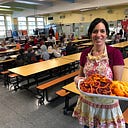How SNAP Needs to Change During the Pandemic
Even if Friday’s Heroes Act were passed, we’d still see a hunger spike. Here’s why.
When Grisel Cardona, a single mother with three young children, tested positive for Covid-19, she feared for more than her life. She feared she would not be able to feed her children.
Cardona, who lives in the Bronx, was forced to leave her job to take care of her children, two of whom are autistic, and receives money for food through the Supplemental Nutrition Assistance Program, or SNAP. Since the start of the pandemic, she has been going to schools for grab-and-go meals and stopping at free, city-provided pantry boxes, but then she became too sick to leave the house.
“I didn’t feel well enough to go out and I didn’t want to go out and get people sick,” she said. “But being a single mom of three, what choice did I have?”
Covid-19 has hit low-income families like Cardona’s the hardest, and hunger has surged during the pandemic. A poll released by Hunger Free America found that among adults, 24 percent skipped meals or cut portions because they lacked enough money for food. That’s about two and a half times the adult hunger rate of 2018.
To compound the problem, food banks and food rescue organizations are shutting down because…

